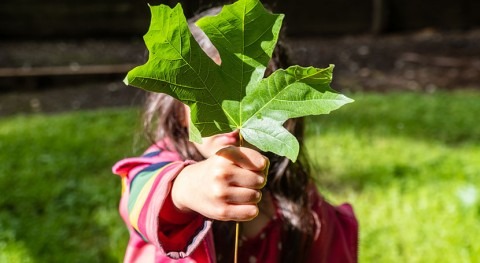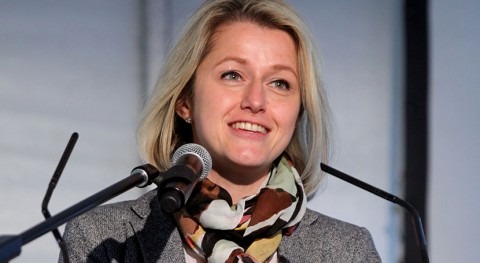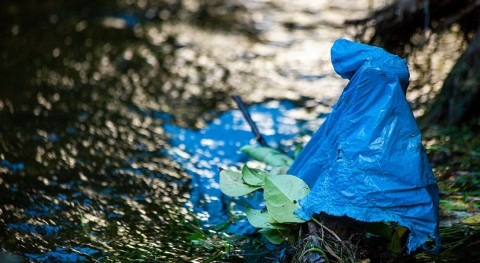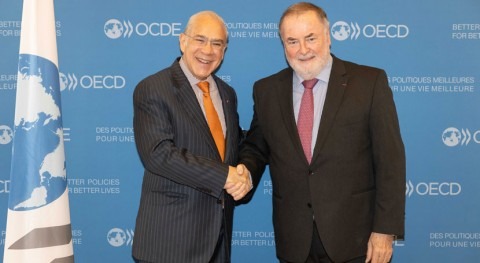In this interview of our series 'Women and Water', we speak to Aziza Akhmouch, in charge of the OECD Water Governance Initiative. Aziza also heads the OECD's Division of Cities, Urban Policy and Sustainable Development, has participated in several editions of the Water Economy Forum, where she was interviewed, and has appeared in iAgua Magazine, iAgua's quarterly magazine in print.
Question: First, we would like to know in detail about your career path up to your current position.
Answer: I first came in contact with the water sector 2002, when I travelled to Argentina to work on the relationships of French multinational companies such as Suez, EDF or France Telecom with the mass media, in a context of serious economic crisis. What sparked my interest were not energy or telecommunications issues, but the arguments and passion in water management discussions. After completing a PhD thesis on these issues, I started working at the OECD in 2007, where I launched the Water Governance programme in 2009. Since then, I have achieved milestones such as the creation of the Water Governance Initiative and the development of the Principles on Water Governance, adopted in 2015 and already endorsed by 140 institutions and actors from all sectors. Currently I head the OECD's Division of Cities, Urban Policy and Sustainable Development, where the Water Governance programme resides.
Mental stress levels rise when water rights are not guaranteed
Q: In the water sector we continue to see an important gender gap. Why do you think this is?
A: The importance of reducing the gender gap in the water sector is evident when we look at the data. Women and girls are more than half of the world's population and often are the most affected by poverty, climate change, food insecurity, lack of health care, and world economic crises. In a large number of developing countries, social pressures dictate that women and girls are the main water providers for their families. This translates into time invested getting water that cannot be put to earning an income in the case of women, or going to school in the case of girls.

The World Health Organization estimates that each day, in 25 countries in sub-Saharan Africa, women use 16 million hours collecting water, instead of using that time for education or paid work. In addition, mental stress levels rise when water rights are not guaranteed. Therefore, I believe that the gap in the water sector is both a cause and an effect of the general gender gap. The greater the water insecurity, the greater the need and the social pressure on women to provide water, with less time left to get training and access employment, resulting in a larger gender gap in other sectors.
There isn't a proper analysis in the water sector to provide decision makers the evidence they need to inform their discussions and help them implement specific actions and policies to increase equity in the sector and lessen discrimination
Q: Does your entity have any programmes and/or tools to foster equality, aimed to bridge the gender gap?
A: Our OECD Gender Initiative examines the existing barriers to gender equality in many policy areas such as education, employment, entrepreneurship, public governance, etc., monitors the progress done by governments to promote gender equality both in OECD member countries and outside the OECD, and provides international good practices and standards. For example, as part of this initiative, the OECD approved in 2015 the Recommendation of the Council on Gender Equality in Public Life, that promotes a government-wide strategy for gender equality reform, sound mechanisms to ensure the accountability and sustainability of gender initiatives, and tools and evidence to inform inclusive policy decisions. The Recommendation provides not only governments, but also parliaments and other entities, with clear guidelines to effectively implement gender equality initiatives, and to improve equal access to public leadership for women and men from diverse backgrounds. Another important part of the Gender Initiative is a data portal that includes selected indicators shedding light on gender inequalities in education, employment, entrepreneurship, health and development, etc., and show how far countries are from achieving gender equality and where action is most needed. The data cover OECD member countries, as well as partner economies including Brazil, China, India, Indonesia, and South Africa.
The greater the water insecurity, the greater the need and the social pressure on women to provide water, with less time to get training and access employment, resulting in a larger gender gap in other sectors
In addition, the goal of our internal network — the OECD Women Network — is making the OECD a more inclusive and diverse place to work. In 2017 the Network organised many workshops and lunches, assigned more than 100 senior mentors to junior female employees, launched new capacity building programmes on diversity and inclusion to raise awareness among senior managers, and even started a new reading club. The OECD is also making progress with regards to employing women and their career advancement: in 2017 more than 10 women were appointed to senior management positions. All of these initiatives contribute to aligning the work inside the OCED organisation with the effort it does to further gender equality in society at large.
Q: Now let us talk about your experience, what difficulties have you faced in your career because you are a woman?
A: None really, up to now.

Q: Are there any other pressing challenges that you think need to be addressed in the sector?
The OECD is also making progress with regards to employing women and their career advancement: in 2017 more than 10 women were appointed to senior management positions
A: I think the most important challenge to bridge the gender gap is being able to quantify it and analyse the reasons behind it. Although the website I mentioned earlier provides some data on key economy and well-being areas, in general there isn't a proper analysis in the water sector to provide decision makers the evidence they need to inform their discussions and help them implement specific actions and policies to increase equity in the sector and lessen discrimination. Therefore, it is necessary to show what works, where and how, in terms of women's participation in water governance. A sound base of knowledge and data provides a baseline to learn and apply successful practices, and to improve the use of solutions in different contexts, whenever they are relevant. Ultimately, that evidence would help to show the effective contribution of women to water governance, and the importance of developing the capacities they need to exercise their role in the sector.
Q: Conversely, what do you think are the main achievements in the sector?
I think the most important challenge to bridge the gender gap is being able to quantify it and analyse the reasons behind it
A: I think an important step in the sector is that international agreements have incorporated the importance of women as actors, leaders, experts and agents of change to achieve fair access to water, including all uses. The importance of involving both women and men in water and sanitation management has been globally recognised, starting with the United Nations Conference on Water held in Mar de Plata in 1977, the International Drinking Water and Sanitation Decade (1981-90), and the International Conference on Water and the Environment held in Dublin (January 1992), that explicitly recognise the key role of women in the supply, management and protection of water. There are also references to the involvement of women in water management in Agenda 21 (Chapter 18) and in the Johannesburg Plan of Implementation. More recently, the Sustainable Development Objectives recognise the role of women to ensure a more inclusive and sustainable development, which is also related to water resource management in terms of social inclusion, poverty reduction, environmental sustainability and food security. The international mandate is clear: the contribution of women to water management — their foresight, knowledge and leadership — is essential for better policies and a better life. We only have to turn this guidance into specific practices, from the local to the national level. And for that we need everyone, women and men!










